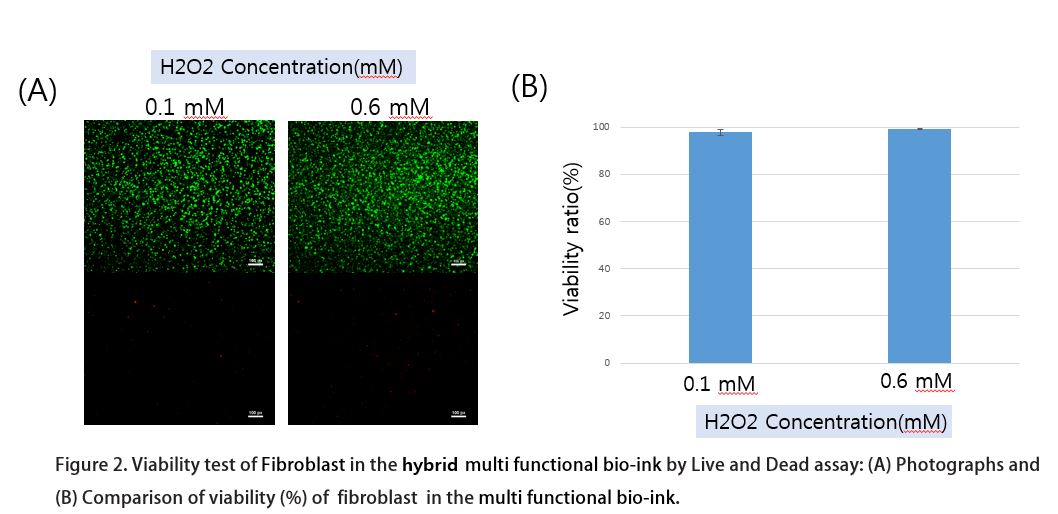Introduction: Bio-printing for complex tissue regeneration is one of the leading issues in tissue engineering and regenerative medicine. Developing highly organized three dimensional scaffolds for complex tissue required the 3D printer and bio-inks. Especially, multi functional bio-ink is critical for regeneration such as vessel integrated bone tissues. Requirement of ideal bio-ink is 1) fast gelation after printing, 2) mechanical integrity for supporting 3D structures, and 3) instructive guidances for complex tissue regeneration. In this study, we developed multi-functional bio-inks based on acrylated hyaluronic acids for functions and tyramine conjugated hyaluronic acids for fast gelation.
Materials and Methods: Hyaluronic acid derivatives (acrylated HA and tyramine conjugated HA) was synthesized by following the previous study[1],[2]. Synthesized HA-ac, HA-try and crossrinkers (HRP,H2O2 and MMP-senstive peptide) were dissolved in a TEA buffer and PBS buffer respectively. Solutions were mixed with varying the concentration of H2O2 and HRP. Gelation of hybrid hydrogel was monitored by observing the viscosity and elastic modulus for 15min using rotational rheometer. The cell-containing of hybrid hydrogels were cultured in DMEM medium. The cells viability in the hybrid hydrogel was measured by the LIVE/DEAD assay and gene expression of cells in each group was measured by using real time PCR.
Results: Optimal gelation time of the hybrid multi-functional bio-ink was screened by varying the concentration of hyaluronic acid, hydrogen peroxide, and HRP. Rheological and compression tests were performed on samples with a fixed HRP concentration of 1.25units to determine the optimal H2O2 concentration (0.1mM and 0.6mM). Gelation of hybrid hydrogel was done within 20 seconds and the elastic modulus of hybrid hydrogels were >1x104 Pa(Figure. 1). Fibroblasts cultured in the hydrogel up to 3 days showed > 95% viability with H2O2 concentration of both 0.1mM and 0.6mM(Figure. 2). For the bone regenration, we used the BMP-2 and osteopontin derived peptides as a functional group. Mesenchymal stem cells cultured in osteogenic bio-ink showed the lineage specific differentiation by increasing ALP, Runx2 and osteocalcin.


Discussion: We developed the hybrid multi functional bio-ink based on hyaluronic acid. This novel bio-ink has two unique features, fast gelation from HA-tyr and biological functions from peptide conjugated HA. The gelation time of this novel bio-ink was less than 20 seconds whereas the gelation time of HA-acrylated hydrogel was 15 minutes[3]. Complex modulus of multi functional bio-ink is >1X104 Pa. These two main characteristics of this hydrogel meet the requirements for ideal bio-ink to construct the complex 3D structures. This hybrid bio-ink is also has higher cellular viability, which can be used for bioprinting of specific cells and biofunctional hydrogels. Biofunctional peptides provides the guidance cues for stem cells in the 3D bio-ink. This multi functional bio-ink can be used for complex tissue engineering and regenerative medicine.
This study was supported by the grant from the Ministry of Health and Welfare in Republic of Korea. (HI14C2143030014)
References:
[1] J. Kim and Y. Park, “Bone regeneration using hyaluronic acid-based hydrogel with bone morphogenic protein-2 and human mesenchymal stem cells”, Biomaterials.Vol. 28, Jan. 2007.
[2] Lee F and Kurisawa M, “An injectable enzymatically crosslinked hyaluronic acid–tyramine hydrogel system with independent tuning of mechanical strength and gelation rate”, Soft Matter. vol.4, Feb. 2008.
[3] J. Kim and Y. Park,“Synthesis and characterization of matrix metalloprotease senstive-low molecular weight hyaluronic acid based hydrogels”, J Mater Sci: Mater Med, Vol. 19, May. 2008